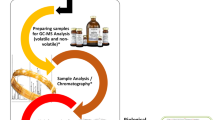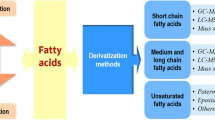Abstract
Diacetoxyscirpenol (DAS), a Fusarium mycotoxin belonging to the trichothecene type A mycotoxins, is able to contaminate food and feed worldwide. Only limited information is available regarding the metabolism of DAS. The present study used ultrahigh-performance liquid chromatography-quadrupole/time-of-flight hybrid mass spectrometry (UHPLC-Q/TOF) to investigate the in vitro phase I and II metabolism of DAS by rat, chicken, swine, goat, cow, and human liver microsomes. An extensive metabolization profile of DAS has been observed. A total of seven phase I and three phase II metabolites of DAS were detected. Among the identified molecules, four phase I metabolites (8β-hydroxy-DAS, neosolaniol, 7-hydroxy-DAS, and its epimer) and two phase II metabolites (4-deacetyl-DAS-3-glucuronic acid and 4-deacetyl-DAS-4-glucuronic acid) were identified for the first time. These results indicate that the major metabolic pathways of DAS in vitro were hydrolyzation (M1–M3), hydroxylation (M4–M7), and conjugation (M8–M10). Qualitative differences in phase I and II metabolic profiles of DAS between the five animal species and human were observed. 4-Deacetyl-DAS was the primary metabolite from liver microsomes of all species, especially human. The in vivo metabolism of DAS in rats and chickens after oral administration of DAS was also investigated and compared. The major metabolites for rats and chickens were 4-deacetyl-DAS and 7-hydroxy-DAS. These results will help to gain a more detailed insight into the metabolism and toxicity of DAS among different animal species and human.

The metabolism of diacetoxyscirpenol in farm animals and human






Similar content being viewed by others
References
Shams M, Mitterbauer R, Corradini R, Wiesenberger G, Dall’Asta C, Schuhmacher R, Krska R, Adam G, Berthiller F (2011) Isolation and characterization of a new less-toxic derivative of the Fusarium mycotoxin diacetoxyscirpenol after thermal treatment. J Agric Food Chem 59:9709–9714
Antonissen G, Martel A, Pasmans F, Ducatelle R, Verbrugghe E, Vandenbroucke V, Li S, Haesebrouck F, Van Immerseel F, Croubels S (2014) The impact of Fusarium mycotoxins on human and animal host susceptibility to infectious diseases. Toxins 6:430–452
Xue H, Bi Y, Wei J, Tang Y, Zhao Y, Wang Y (2013) New method for the simultaneous analysis of types A and B trichothecenes by ultrahigh-performance liquid chromatography coupled with tandem mass spectrometry in potato tubers inoculated with Fusarium sulphureum. J Agric Food Chem 61:9333–9338
Tittlemier SA, Gaba D, Chan JM (2013) Monitoring of Fusarium trichothecenes in Canadian cereal grain shipments from 2010 to 2012. J Agric Food Chem 61:7412–7418
van Egmond HP, Schothorst RC, Jonker MA (2007) Regulations relating to mycotoxins in food: perspectives in a global and European context. Anal Bioanal Chem 389:147–157
Ayral AM, Dubech N, Le Bars J, Escoula L (1992) In vitro effect of diacetoxyscirpenol and deoxynivalenol on microbicidal activity of murine peritoneal macrophages. Mycopathologia 120:121–127
Rio B, Lautraite S, Parent-Massin D (1997) In vitro toxicity of trichothecenes on human erythroblastic progenitors. Hum Exp Toxicol 16:673–679
Grandoni KM, Gentry PA, Holub BJ, Yagen B (1992) Trichothecene mycotoxins inhibit phosphoinositide hydrolysis in bovine platelets stimulated with platelet-activating-factor. Toxicology 72:51–60
Lautraite S, Rio B, Guinard J, Parent-Massin D (1997) In vitro effects of diacetoxyscirpenol (DAS) on human and rat granulo-monocytic progenitors. Mycopathologia 140:59–64
Jesenska Z, Bernat D (1994) Effect of mycotoxins on in vitro movement of tracheal cilia from one-day-old chicks. Folia Microbiol 39:155–158
Kubena LF, Edrington TS, Harvey RB, Phillips TD, Sarr AB, Rottinghaus GE (1997) Individual and combined effects of fumonisin B1 present in Fusarium moniliforme culture material and diacetoxyscirpenol or ochratoxin A in turkey poults. Poult Sci 76:256–264
Hussein HS, Brasel JM (2001) Toxicity, metabolism, and impact of mycotoxins on humans and animals. Toxicology 167:101–134
Hassanane M, Abdalla E, El-Fiky S, Amer M, Hamdy A (2000) Mutagenicity of the mycotoxin diacetoxyscirpenol on somatic and germ cells of mice. Mycotoxin Res 16:53–64
Swenson DH, Lin JK, Miller EC, Miller JA (1977) Aflatoxin B1-2,3-oxide as a probable intermediate in the covalent binding of aflatoxins B1 and B2 to rat liver DNA and ribosomal RNA in vivo. Cancer Res 37:172–181
Ohta M, Matsumoto H, Ishii K, Ueno Y (1978) Metabolism of trichothecene mycotoxins. II. Substrate specificity of microsomal deacetylation of trichothecenes. J Biochem 84:697–706
Roush WR, Marletta MA, Russo-Rodriguez S, Recchia J (1985) Trichothecene metabolism studies: isolation and structure determination of 15-acetyl-3.alpha.-(1′.beta.-D-glucopyranosiduronyl)scirpen-3,4.beta.,15-triol. J Am Chem Soc 107:3354–3355
Bauer J, Bollwahn W, Gareis M, Gedek B, Heinritzi K (1985) Kinetic profiles of diacetoxyscirpenol and two of its metabolites in blood serum of pigs. Appl Environ Microbiol 49:842–845
Sakamoto T, Swanson SP, Yoshizawa T, Buck WB (1986) Structures of new metabolites of diacetoxyscirpenol in the excreta of orally administered rats. J Agric Food Chem 34:698–701
Wu QH, Dohnal V, Huang LL, Kuca K, Yuan ZH (2010) Metabolic pathways of trichothecenes. Drug Metab Rev 42:250–267
Swanson SP, Helaszek C, Buck WB, Rood HD Jr, Haschek WM (1988) The role of intestinal microflora in the metabolism of trichothecene mycotoxins. Food Chem Toxicol 26:823–829
Wu Q, Dohnal V, Kuca K, Yuan Z (2013) Trichothecenes: structure-toxic activity relationships. Curr Drug Metab 14(6):641–660
Swanson SP, Nicoletti J, Rood HD Jr, Buck WB, Cote LM, Yoshizawa T (1987) Metabolism of three trichothecene mycotoxins, T-2 toxin, diacetoxyscirpenol and deoxynivalenol, by bovine rumen microorganisms. J Chromatogr 414:335–342
Kemppainen BW, Riley RT, Pace JG, Hoerr FJ (1986) Effects of skin storage conditions and concentration of applied dose on [3H]T-2 toxin penetration through excised human and monkey skin. Food Chem Toxicol 24:221–227
Wen B, Zhu M (2015) Applications of mass spectrometry in drug metabolism: 50 years of progress. Drug Metab Rev 47(1):71–87. doi:10.3109/03602532.2014.1001029
Meyer MR, Maurer HH (2012) Current applications of high-resolution mass spectrometry in drug metabolism studies. Anal Bioanal Chem 403:1221–1231
Yang S, Li Y, Cao X, Hu D, Wang Z, Wang Y, Shen J, Zhang S (2013) Metabolic pathways of T-2 toxin in in vivo and in vitro systems of Wistar rats. J Agric Food Chem 61:9734–9743
Yang S, Shi W, Hu D, Zhang S, Zhang H, Wang Z, Cheng L, Sun F, Shen J, Cao X (2014) In vitro and in vivo metabolite profiling of valnemulin using ultraperformance liquid chromatography-quadrupole/time-of-flight hybrid mass spectrometry. J Agric Food Chem 62:9201–9210
Yang S, Zhang H, De Saeger S, De Boevre M, Sun F, Zhang S, Cao X, Wang Z (2015) In vitro and in vivo metabolism of ochratoxin A: a comparative study using ultra-performance liquid chromatography-quadrupole/time-of-flight hybrid mass spectrometry. Anal Bioanal Chem. doi:10.1007/s00216-015-8570-0
Yang S, Zhang H, Beier RC, Sun F, Cao X, Shen J, Wang Z, Zhang S (2015) Comparative metabolism of Lappaconitine in rat and human liver microsomes and in vivo of rat using ultra high-performance liquid chromatography-quadrupole/time-of-flight mass spectrometry. J Pharm Biomed Anal 110:1–11
Lowry OH, Rosebrough NJ, Farr AL, Randall RJ (1951) Protein measurement with the Folin phenol reagent. J Biol Chem 193:265–275
Wu QH, Wang X, Yang W, Nussler AK, Xiong LY, Kuca K, Dohnal V, Zhang XJ, Yuan ZH (2014) Oxidative stress-mediated cytotoxicity and metabolism of T-2 toxin and deoxynivalenol in animals and humans: an update. Arch Toxicol 88(7):1309–1326
Tripathi SP, Bhadauriya A, Patil A, Sangamwar AT (2013) Substrate selectivity of human intestinal UDP-glucuronosyltransferases (UGTs): in silico and in vitro insights. Drug Metab Rev 45:231–252
Welsch T, Humpf HU (2012) HT-2 toxin 4-glucuronide as new T-2 toxin metabolite: enzymatic synthesis, analysis, and species specific formation of T-2 and HT-2 toxin glucuronides by rat, mouse, pig, and human liver microsomes. J Agric Food Chem 60:10170–10178
Maul R, Warth B, Kant JS, Schebb NH, Krska R, Koch M, Sulyok M (2012) Investigation of the hepatic glucuronidation pattern of the Fusarium mycotoxin deoxynivalenol in various species. Chem Res Toxicol 25:2715–2717
Senter LH, Sanson DR, Corley DG, Tempesta MS, Rottinghaus AA, Rottinghaus GE (1991) Cytotoxicity of trichothecene mycotoxins isolated from Fusarium sporotrichioides (MC-72083) and Fusarium sambucinum in baby hamster kidney (BHK-21) cells. Mycopathologia 113(2):127–131
Madhyastha MS, Marquardt RR, Abramson D (1994) Structure-activity relationships and interactions among trichothecene mycotoxins as assessed by yeast bioassay. Toxicon 32(9):1147–1152
Bergmann F, Yagen B (1989) Structure-activity relationships for the direct toxic action of trichothecenes on rat brain. Arch Toxicol 63(2):155–156
Acknowledgments
This work was supported by the National Natural Science Foundation of China (NSFC) grant (No. U1301214), the International Science & Technology Cooperation Program of China (2012DFG31840), and Special Fund for Agro-scientific Research in the Public Interest (201203040). Furthermore, the authors would like to acknowledge Ying Wang, Haixia Wu, Kaili Liu, Xiaoli Song, Yanshen Li, and Lu Zhang for their practical work.
Conflict of interest
The authors declare that they have no competing interests.
Author information
Authors and Affiliations
Corresponding author
Electronic supplementary material
Below is the link to the electronic supplementary material.
ESM 1
(PDF 479 kb)
Rights and permissions
About this article
Cite this article
Yang, S., De Boevre, M., Zhang, H. et al. Unraveling the in vitro and in vivo metabolism of diacetoxyscirpenol in various animal species and human using ultrahigh-performance liquid chromatography-quadrupole/time-of-flight hybrid mass spectrometry. Anal Bioanal Chem 407, 8571–8583 (2015). https://doi.org/10.1007/s00216-015-9016-4
Received:
Revised:
Accepted:
Published:
Issue Date:
DOI: https://doi.org/10.1007/s00216-015-9016-4




